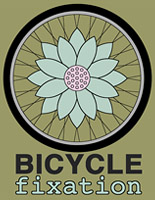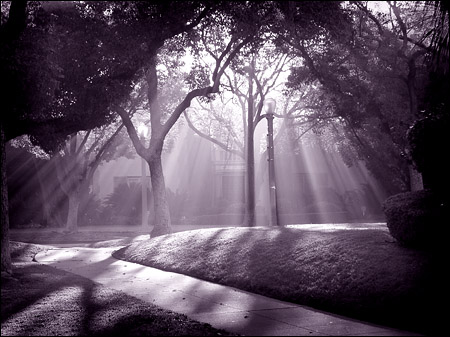
A corner of Fourth Street
On this day, between Cochran and Wilton, I encountered eight cyclists going the other way, evidently (to judge from the hour, their attire, and their luggage) on their morning work commutes. What's more, five of them were women, the "indicator species" for good cycling infrastructure.
That doesn't seem like much, but I didn't count more than twelve cars in the same stretch--and it might have been fewer, though I didn't keep a strict count.
Not bad for LA. Fourth is slated to become a "Bicycle Friendly Street" soon--LA planning jargon for what other places call "bicycle boulevards" or (my favorite) "complete streets."
But nothing's been done to it so far, except to place sharrows and fill a couple of the nastier potholes.
Tuesday's Bike Plan Implementation Team meeting, which I hope to attend, will discuss the city's plan for the first few bicycle friendly streets, and I have heard that Fourth will be among the first, if not the first.
I look forward to seeing what they plan for it. It's done pretty well (for LA) on its own. And it has a tremendous potential
Richard Risemberg on Thu, 30 Jun 2011 21:10:56 -0800 [link]
On Orange 20's blog, I blither on about what makes a practical bike, and at Flying Pigeon LA I pontificate on women, bike lanes, and mode share.
Richard Risemberg on Sun, 26 Jun 2011 13:05:38 -0800 [link]
Fascinating Results
For example, to the question, "What would cause you to start or increase your cycling?" 17 reasons cited, and the top three were:
- Convenience (22%)
- Infrastructure (14%)
- Self-confidence with cycling (11%)
- (Total of the three, 47%)
To the question, "Why do you use your bicycle for trips?" (I know, not the best wording. I took the survey but can't recall if this was the original phrasing), 20% report enjoyment (e.g. sense of "freedom" or "it's beautiful and pleasant"), 14% cited support/encourage the cycling community, and 10% cited parking fees and headaches.
While the age groupings were fairly predictable, with the highest percentage going to women age 20-30 (27.2%), followed by 31-40 (23.0%). It was a pleasant surprise to find that 19.2% of women reported their age to be between 41-50, and 16.4% between 51-60.
Rural and suburban women were less likely to use bikes for daily trips, and when they got on their bicycle, tended to ride further. This implies that rural and suburban women are recreational riders and spend fewer days on the bike. This would have implications for issues surrounding automobile traffic reduction.
More to Come?
This is an excellent survey that looks into a population largely overlooked. The results both confirm and call into question several assumptions we have about cyclists. We need to be cautious about drawing any broad conclusions from this data, however. The validity of self-reported data, limited sample size, and low number of responses per question are problematic.
I see lot of great opportunity for future research both in terms of analyzing this data set, and for conducting additional projects. For example, the data shows that rural/suburban women are more likely to wear a helmet. Age, self-confidence on the bike, and comfort around traffic are all potentially related, though the findings do not discuss this directly. Future surveys could broaden the population to include men for a closer comparison of gender differences.
Act Now
This is not to suggest that those on the operational and implementation side need to wait for further research to be conducted. On the contrary, this is a small wake-up call. Act to implement cycling infrastructure, improve cycling safety, and increased cycling population. Incentivize commercial concerns to install bike parking, and support cycling-related proposals.
By and large, this Women's Cycling Survey is an important step in understanding the hows and whys women bicycle. Researcher, Anna Sibley, and her colleagues should be commended for taking it. But there is still a long road ahead, and it is up to the rest of the cycling world to help her finish the trip.
If you are a cyclist, and a bicycling survey comes your way. Take it, and participate in the process.
Notes:
The survey was conduced in early 2010 as part of their ongoing Women Cycling Project. There were a total of 13,286 respondents, some from countries other than the U.S. However, response rate for any given question was substantial lower. All quoted text from APBP.
You may read the final report, dated September 14, 2010.
Below are summary documents for three of the survey's questions. They are beautifully designed in brochure style with lots of pictures and charts. (Downloadable PDF files, each apx. 11MB to 16MB in size). As of this post, these are the only three available:
Gina Morey on Wed, 22 Jun 2011 17:12:13 -0800 [link]
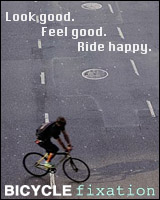 With the economy in a double-dip recession for everyone except the Bailout Bandits, we have decided to reprise our pre-season sale. We have lowered prices prices on our Classic Wool Knickers and City Knickers v2.0 for the summer! (Or till we run out of stock on the current inventory.)
With the economy in a double-dip recession for everyone except the Bailout Bandits, we have decided to reprise our pre-season sale. We have lowered prices prices on our Classic Wool Knickers and City Knickers v2.0 for the summer! (Or till we run out of stock on the current inventory.)So for the next several weeks, you can buy fine wool gabardine or hemp blend knickers for only $112 (plus shipping), fine riding pants that will serve you well on long rides or short, in the dead of winter or in summer's heat.
No need to look shabby on your commute, your shopping trip, or your weekend joyride! And you'll be as elegant off the bike as on.
We also have extra-long socks to go with your knickers, as well as handy hats, clever bells, and of course Kookaburra Wash to keep your duds clean and soft.
And don't forget a few clearance items, including Four Season Jerseys and Town & Country Shorts (the last two being in very short supply).
Check them all out in our shopping cart!
Richard Risemberg on Mon, 20 Jun 2011 20:18:20 -0800 [link]
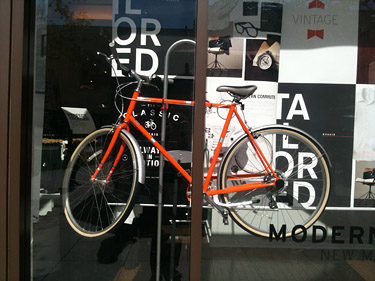 I thought I would save Rick the effort this time and make this post myself. Has any of you noticed the blush of bicycles appearing in shop windows recently? Not bike shops, but other retailers. Big ones. Since last fall we have seen a bicycle in the window of Gap, Anthropologie, Club Monaco and Tommy Bahama. We were pleased to see it even if, as in one case, the forks were mounted backwards. But was it a local trend or something bigger?
I thought I would save Rick the effort this time and make this post myself. Has any of you noticed the blush of bicycles appearing in shop windows recently? Not bike shops, but other retailers. Big ones. Since last fall we have seen a bicycle in the window of Gap, Anthropologie, Club Monaco and Tommy Bahama. We were pleased to see it even if, as in one case, the forks were mounted backwards. But was it a local trend or something bigger?It turns out that the trend is nationwide and was picked up by the radio program, Marketplace. You can read the transcript and see their brief slide slow.
At the end of the segment, reporter Andrea Bernstein concludes, "Except that next year, the retailers we spoke with said they'll be off bikes, and on to the next big thing."
Will she be right? Yes, inevitably on to the next big thing. It is up to us to make sure that bicycles are (and remain) "the next big thing." Anthropologie, you might want to start thinking about a line of handlebar bags. -- Yes, you can work in a strap for a scented candle if you want.
Gina Morey on Fri, 17 Jun 2011 09:55:43 -0800 [link]
And of course I've afflicted Orange 20 as well, where I note that Hermosa Beach Gets It...while LA still seems a little bit befuddled.
Richard Risemberg on Thu, 16 Jun 2011 14:32:05 -0800 [link]
Several hours after posting the note below, we heard good news: Kang Hu of LADOT confirmed today in an email sent to LACBC and Bicycle Fixation that the Wilshire Bus Lanes will be open to bicyclists, just as the Downtown rush-hour bus lanes are! He adds, "We will make sure all the signs reflect that regulation."
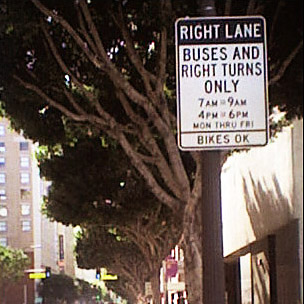 It looks as though Los Angeles is on the verge of implementing its first onstreet bus-only lanes soon. Wilshire Boulevard, the closest thing LA has to a main drag and one of the busiest commute corridor in the country, and it is almost always crowded during the week. Crowded with cars, that is.
It looks as though Los Angeles is on the verge of implementing its first onstreet bus-only lanes soon. Wilshire Boulevard, the closest thing LA has to a main drag and one of the busiest commute corridor in the country, and it is almost always crowded during the week. Crowded with cars, that is.And to little avail: LADOT engineer Kang Hu recently released figures showing that the Rapid buses already carry more passengers down Wilshire at rush hour than all the cars in aggregate. That is, 29,000 people on the bus versus 24,000 in cars. Speeding up bus service (and repaving the right lane where the buses would run, as envisioned, to smooth up the ride) would almost certainly entice even more people onto the buses, which already carry a good proportion of white-collar as well as blue collar and service workers. (I ride them quite often and see.) With one bus replacing over 65 cars at rush hour (when the buses are full and the cars almost never are), it would seem to make sense to give more support to the travel mode that works better for all...but of course, this is America. The NIMBYs have been fighting it.
Beverly Hills, which ironically is one of the areas most congested with excessive cars and would have benefited greatly from the lanes, won't have them--showing that "more money than brains" is more than just a facile put-down. So-called "Condo Canyon," a mile of high-end high-rises between Beverly Hills and Westwood, will also be excluded--they were afraid there wouldn't be room for their Lexuses and range Rovers, though how making sure the street is crowded with thousands more cars than could otherwise be the case. Of course, one reason to become rich is so that you can bully others, even if it works against you, so, unless Metro overrules the City Council's recommendations, which is unlikely, the buses--and all the cars--will have to slow down for that stretch of the route as well.
Be that as it may, we will, it seems, get the benefits of 7.7 miles of rush-hour busway on Wilshire, which is better than nothing, or even than the 5.5 miles one council member was insisting upon, since hoity-toity Brentwood was also uncomfortable with the concept. (Seems like rich people certainly love to stand in the way of progress or a better life for all sometimes....)
Why is all this in a magazine dedicated mostly to cycling?
Because the assumption in the bicycle community here has been that these lanes would be shared with cyclists, forming a high-quality rush-hour bike route between Downtown and the Westside. After all, Downtown's own rush-hour bus lanes are shared with bikes, as you see from the sign in the picture, snapped on Spring Street. naturally these will be too....
Or will they?
I recalled that when I first asked whether these lanes would be shared with bikes, the city bureaucracy seemed to think it impractical. (Perhaps they didn't know they were already doing it, or that German cities have done so for years, with a gain in cyclist safety.)
So I did a little research, and what I found did not comfort me...to wit, language stating that "Bicycles and private vehicles turning right can use the lanes."
Does this mean cars making right turns can use the lanes, or does it mean that cars and bikes both can use the lanes only when turning right?
I have calls in to Metro and the LADOT asking just that. The city's cyclists have devoted a lot of time to promoting these bus lanes partly on the understanding that they would be bike lanes as well, as they are Downtown.
But in Los Angeles, which has not always been steadfast or straightforward in its support of bicycles, it pays to make sure.
Richard Risemberg on Wed, 15 Jun 2011 14:28:13 -0800 [link]
What interested me in particular during last Tuesday's meeting was a little sequence that occurred while one of the city's environmental consultants was describing the parameters that trigger CEQA reviews and occasionally necessitate an Environmental Impact Report. (CEQA is the Californa Environmental Quality Act.)
Among these parameters are Level of Service changes--what occurs when, say, a bike path takes away a motor vehicle lane, or motor vehicle parking, and the road czan no longer accommodate as many cars.
It is assumed that only cars carry passengers about the city, and that the number of cars being driven will never drop. Mode switching to transit or bicycling is never counted. Replacing one car parking space with a corral that can hold twelve bicycles does not increase customer parking in a commercial zone.
Such are the assumptions.
At one point I asked why we couldn't refer to data from other cities that have installed bike lanes and bike corrals and gathered data that shows these assumptions to be, in fact, wrong.
The answer (which I've heard before) is that "Los Angeles is different from" San Francisco, or Toronto, or Groningen, or even congested New York (where pedestrianisation and bike lanes have improved safety, boosted retail receipts, and even in most cases improved the flow of motor traffic!).
Well, it's not that different, but they keep telling us it is, as an excuse not to look at truly pertinent data that would require them to think outside the business-as-usual box.
A little while later, the same (very nice, by the way) consultant and the DOT's engineers were talking about the Synchros program and the algorithm it uses to predict Level of Service changes. So I raised my hand again (okay, I butted in as usual) and asked, oh-so-sweetly, where the data had been gathered that the algorithm used to make these predictions.
"Oh, it came from nineteen Midwestern towns...."
And so I asked again, "And how are these nineteen Midwestern towns any more similar to Los Angeles than Toronto?"
The answer, of course, was that they were not.
And that is the sort of thing we're up against here in Los Angeles. And probably in your city too.
Now to be fair, LADOT and Planning are in the process of slowly moving over to calculations based on Multi-Modal Level of Service, which will include throughput generated by bicycles and transit as well as cars, and thus provide more realistic predictions.
But they haven't done so yet. And I wonder how many other outdated, inadequate, or simply biased assumptions are built into the complex calculations city departments use to justify building--or not building!--bicycle infrastructure.
Go to your local planning meetings, my friends. And ask the right questions!
You won't fix these things right away, but you've got to start sometime.
Richard Risemberg on Thu, 09 Jun 2011 20:55:39 -0800 [link]
Richard Risemberg on Wed, 08 Jun 2011 17:25:03 -0800 [link]
See "You Can Ride but You Can't Park", uploaded just this evening.
Richard Risemberg on Sat, 04 Jun 2011 18:59:04 -0800 [link]
At Orange 20, I moan and groan about the runaround we seem to be getting from the DOT and the City Council office, which is delaying our chance of getting the bike corral that Hel-Mel businesses signed up for and have promised to maintain...see Parking Perceptions.
And Flying Pigeon LA gets a more general rant on LA's desperate lack of parking equity for cyclists, and its odd belief that you don't have to leave your bike to get things done when you reach your destination: Networks & Destinations.
Both chock full of links to background material too.
Richard Risemberg on Wed, 01 Jun 2011 15:22:53 -0800 [link]
